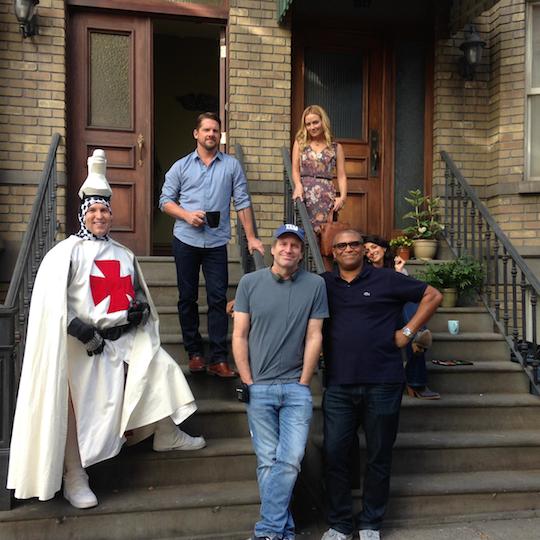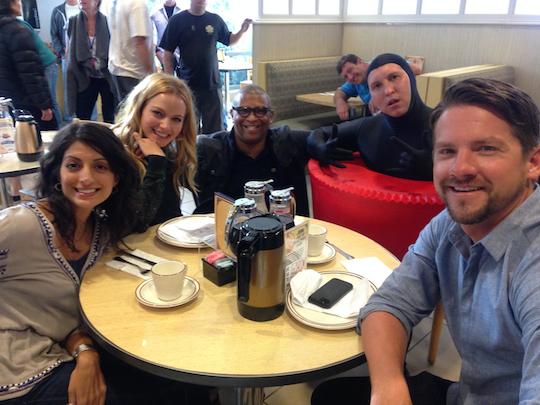02/04/15 by Reggie | Hudlin 100 2014 | Comments Off on Top Ten Books To Read For Black History Month
One of my oldest friends Pierre Paradise was inspired by the READ A BOOK animated video and asked if I would put together a list of suggested books for people to read for black history month? I thought that was a fine idea but as I assembled the list I realized there are so many great books that I haven’t read so I know this list has many important books missing. That said, reading all these books will make you a better person, so here we go:
10. WHO’S AFRAID OF POST BLACKNESS?
By Toure
Good book about challenging the definitions of black culture that have become a straitjacket to the younger generation.
9. THE WIND DONE GONE
by Alice Randall
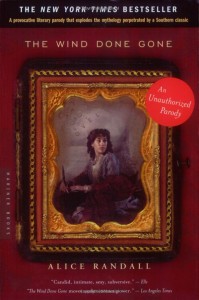
It’s GONE WITH THE WIND told from the point of view of Scarlett O’Hara’s black half sister, and by doing so corrects all the nonsense in the first book. A “meaningful parody”, indeed.
8. MIDDLE PASSAGE
by Charles Johnson
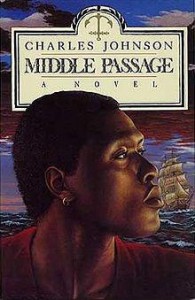
A free black man ends up on a slave ship heading to Africa to pick up cargo, which not only includes what may be the first people on Earth, but their God as well. This leads to a mutiny, a slave revolt and nature itself striking back. National Book Award winner and very well deserved.
7. FACES AT THE BOTTOM OF THE WELL
by Derrick Bell
Bell was a professor at Harvard Law School where one of his devoted students was Barack Obama. One of the reasons he was so revered was his penchant for illustrating race based legal issues with sci fi morality tales like the ones collected in this book, which inspired the TV special COSMIC SLOP.
6. WILD SEED
by Octavia Butler
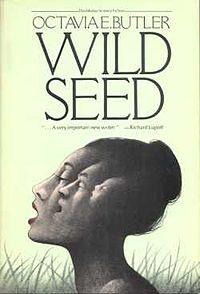
The greatest of all black science fiction stories and part of a trilogy, which will you read in full once you check out the first book. It’s an epic love story between two powerful…mutants? Gods?…from Africa during slavery.
5. MUMBO JUMBO
by Ishmael Reed
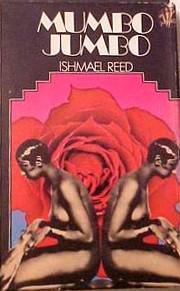
I’m a big fan of George Clinton and Parliament-Funkadelic, and this book is the literary equivalent of one of their classic albums. Funny, funky, brilliant and soulful it is the embodiment of the phrase “nothing is good unless you play with it”.
4. THE DEATH OF RHYTHM AND BLUES
by Nelson George
This is the definitive document on the assimilation of black culture into the American mainstream.
3. STANDING AT THE SCRATCH LINE
by Guy Johnson
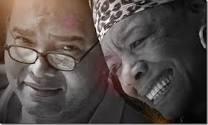
Guy Johnson and his mother, Maya Angelou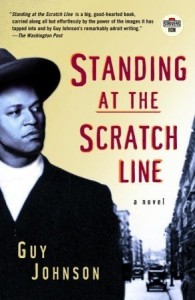
A multigenerational family epic of kickassery that reads like a Blaxploitation movie written by world-class author.
2. THE AUTOBIOGRAPHY OF MALCOLM X
by Malcolm X with Alex Haley
I don’t know how you can call yourself any kind of educated black person without reading this book.
1. INVISIBLE MAN
by Ralph Ellison
I reread this book every couple of years and get something new out of it every time.
01/30/15 by Reggie | Goodies, Interviews | Comments Off on The Producer of Django Unchained Has Some Thoughts on Hollywood’s Race Problems
By Nate Jones at Vulture.com
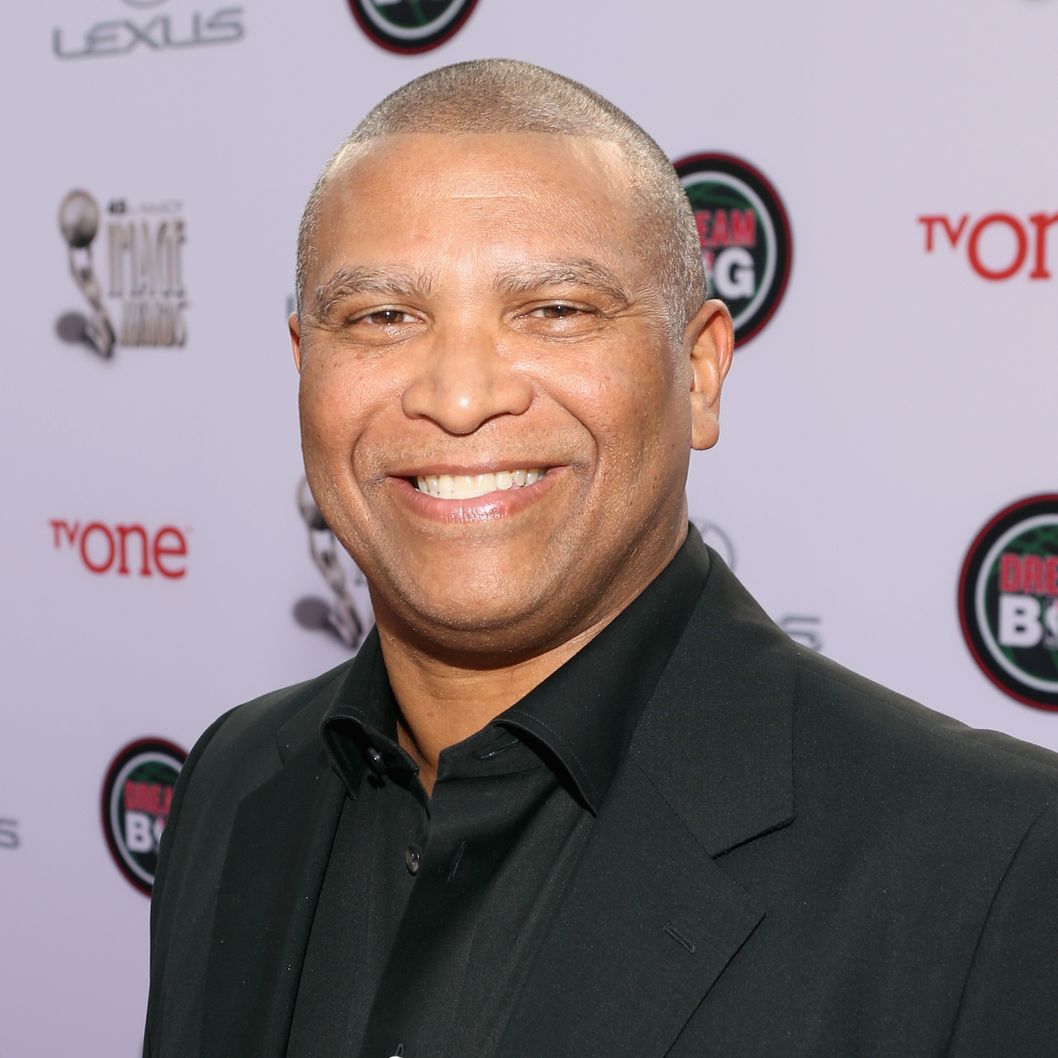
Reginald Hudlin directed House Party while he was still in his 20s; produced Django Unchained, The Boondocks, and The Bernie Mac Show; and helps put on the NAACP Image Awards. So when he wants to talk about race in Hollywood, you listen. In a new essay for The Hollywood Reporter, Hudlin uses the recent Selma Oscar snub to talk about the struggles of the film industry as a whole. “It’s easier for a black person to become president of the United States than it is to be president of a movie studio,” he notes, arguing that, “given the shrinking white population in this country, the lack of people of color in the suites and on the screens is just bad business.” Though the industry will say things have improved since the ’50s, Hudlin notes that many of the excuses for Hollywood’s lack of diversity are the same: Back then, those in power worried openly about turning off southern audiences; now they say the same thing about the international market. Both times, he says, they were wrong.
To make Hollywood walk the walk of its diversity talk, Hudlin proposes “taking action at every point in the food chain”: more internships to get young people of color into the industry, a greater emphasis on multiracial casting, and diversity bonuses for executives. Also, he says, we should change the way we talk about movies: “It would be great if the phrase ‘black film’ wasn’t just used when a movie makes less than $100 million.”
01/30/15 by Reggie | Announcements, Goodies | Comments Off on Anthony Anderson to host NAACP awards

Anthony Anderson
Special to the AmNews
Hollywood will be celebrating its fabulous Blackness with the the 46th NAACP Image Awards, a two-hour star-studded (live) event Friday, Feb. 6, on TV One at 9p.m. (ET/PT tape-delayed).
I’ve had the pleasure of working with host Anthony Anderson (in an indie film), and I know that he’s a hard-working man, despite his comedic persona. So Anderson hosting the NAACP Image Awards for the second time isn’t a surprise, but a welcoming confirmation.
Unless you reside under a very large and isolated rock, you know that Anderson is currently executive producing and starring in, alongside Laurence Fishburne and Tracee Ellis Ross, the ABC series “Black-ish,” for which he is also nominated for an Image Award this year.
“It is an honor and privilege to be asked back to host the NAACP Image Awards,” said Anderson. “The nominees this year are stellar and a testament to the talented individuals in our community. As a nine-time Image Award nominee, I could not be more proud, and I look forward to holding the record for most nominations without a win!”
In addition, also returning are Reginald Hudlin and Phil Gurin as executive producers. The production team includes Tony McCuin as director, Byron Phillips as producer and Robin Reinhart as the talent producer. Actor and musician Lance Reddick will be the in-show announcer.
Hudlin is the executive producer and writer of the “Black Panther” animated series and executive producer of “The Boondocks” animated series. From 2005 to 2009, Hudlin was the first president of entertainment for BET Networks, creating some of the networks’ highest rated shows during his tenure.
This summer, he partnered with the Academy of Motion Picture Arts & Sciences and the Hollywood Bowl to produce a live cinematic concert experience titled “The Black Movie Soundtrack,” which was a critical and commercial success.
“Building on the momentum and success from last year, we are planning an extraordinary show and securing today’s leading talent to be part of the celebration,” Hudlin and Gurin said in a statement. “It is an honor for us to work with the NAACP and TV One to create a show that recognizes such a diverse group of talented people, and we look forward to producing one of the premier awards show telecasts in America.”
The NAACP Image Awards celebrates the accomplishment of people of color in the fields of television, music, literature and film and also honors individuals or groups who promote social justice through creative endeavors. Winners will be voted on by NAACP members and announced when the envelopes are opened Thursday, Feb. 5 during the awards ceremony for non-televised categories. The remaining categories will be announced live on stage during the two-hour, star-studded TV One telecast Friday, Feb. 6. The telecast will also include a one-hour, pre-show airing live from the red carpet (8p.m. ET/PT tape-delayed).
For all information and the latest news, please visit www.naacpimageawards.net
Facebook: /naacpimageaward
Twitter: @naacpimageaward
01/30/15 by Reggie | Goodies, Milestone | Comments Off on Hudlin & Cowan On “Milestone 2.0”: “We’re Not In The Nostalgia Business”
Albert Ching, Managing Editor, Comic Book Resources

Milestone Media is back.
The return was made official earlier today, with the announcement that Denys Cowan and Derek Dingle — two of the founders of the original Milestone — have joined forces with Hollywood and comics veteran Reginald Hudlin to form what’s being referred to as “Milestone 2.0.”
CBR News sat down with both Cowan and Hudlin, who explained that in this new incarnation, the “Media” part of the name “Milestone Media” comes with an extra emphasis.
“This company is called Milestone Media,” Hudlin told CBR. “[Milestone] was never just a comic book company. [The] name indicated being bigger than a comic book company. and now that’s true more than ever. We’re going to be working on multiple platforms, and all kinds of ways of presenting these ideas.”
In fact, the next Milestone-related media project was actually revealed months before today’s news, an in-development live-action “Static Shock” digital series to be produced for Warner Bros. by Hudlin and Cowan, starring Static — one of Milestone’s flagship characters, and the star of an animated “Static Shock” series that ran from 2000 to 2004.
But the focus on “Media” doesn’t mean that Milestone is shying away from its comic book roots. Founded by Black comics and publishing professionals Cowan, Dingle, Michael Davis and the late Dwayne McDuffie, the company started with the goal of increasing representation of minorities in comics, both characters and creators. Milestone debuted in 1993 under a publishing deal with DC Comics, with “Hardware,” “Blood Syndicate,” “Iconic” and “Static” all running for dozens of issues before the imprint ended in 1997.
 The characters have appeared sporadically since then — including “Static Shock” being incorporated into the DC Universe’s New 52 line in 2011 — and it looks like the new Milestone will continue this relationship with DC, while also expanding to other publishers.
The characters have appeared sporadically since then — including “Static Shock” being incorporated into the DC Universe’s New 52 line in 2011 — and it looks like the new Milestone will continue this relationship with DC, while also expanding to other publishers.
“We’re working with DC on stuff,” Cowan said to CBR. “We’re currently speaking to a number of different publishers about a number of different projects that they want to do with us. DC’s an important partner for us. We’re exploring everything that’s being put in front of us. It’s been a very busy, exciting time. Hearing people’s enthusiasm about Milestone has been very encouraging to us.”
“Obviously Milestone and DC have a great history together,” Hudlin added. “We’re going to be doing more projects together. but we’re going to be doing business with a lot of different companies. Other publishers, other media companies.”
Other than the “Static Shock” live-action series, the details of exactly what the new Milestone is working on remain to be revealed. But Hudlin said there are “several other deals in motion” and more news will be coming “pretty soon,” as the revived company looks to structure itself based on “maximum flexibility for maximum creativity.”
“I look at what Mark Millar does and I’m very inspired,” Hudlin said.
Milestone 2.0 isn’t something that developed overnight — the origins date back to 2011. In February of that month, Hudlin organized a launch party at Golden Apple in Los Angeles for his website “Reggie’s World,” an online storefront to purchase comics by himself and like-minded creators. Dwayne McDuffie, shortly following the release of the “All-Star Superman” animated adaptation that he wrote, was scheduled to appear at the event, along with Hudlin, Cowan, Rashida Jones, Ziggy Marley and more.
“Dwayne was kind of the unofficial godfather, because he was so helpful to so many up and coming comic book people, like myself,” Hudlin said, citing McDuffie long with Cowan and Kyle Baker — as his three mentors in comics.
As comics fans know well, McDuffie tragically passed away at age 49, a day before his scheduled appearance at Golden Apple. The launch party turned into an ersatz memorial for the prolific writer, who beyond his Milestone work was a frequent contributor to both Marvel and DC’s superhero lore, along with numerous credits in animation.
“It was supposed to go from 7 to 9,” Hudlin said of the event. “It ended up starting at 6. As soon as I got there, there was this mob around the block. And it went to about 11 o’clock. It just kept going and going. At a certain point, it seemed like every Black creator on the west coast was in the room. We all gave some remarks about Dwayne. It was a celebration, it was sad, it was joyous, it was all these things.”
 “Golden Apple had ordered all these extra books for the event,” Hudlin continued. “By the end of the night, the stocks were bare. you could not find a copy of ‘Black Panther,’ or any Black character. The place was just stripped.”
“Golden Apple had ordered all these extra books for the event,” Hudlin continued. “By the end of the night, the stocks were bare. you could not find a copy of ‘Black Panther,’ or any Black character. The place was just stripped.”
A couple of weeks later, many of the same names assembled at a more traditional memorial for McDuffie, with Hudlin, Cowan and Dingle all in attendance.
“After the event, Derek goes to Dennis and myself and says, ‘It’s been too long. We have to restart Milestone,'” Hudlin related. “Basically, at that moment, that was it. Milestone had reformed. Now, there was two years of legal paperwork after that. But that didn’t matter. The moment was right then. It was the call to arms. We’ve got to do this. There was nothing to say.”
Despite being an integral part of this new venture, Hudlin wasn’t a part of the original Milestone Media. His background is primarily in film and TV, having directed features including “House Party” and “Saturday Night Live” spinoff “The Ladies Man,” plus episodes of sitcoms like “Modern Family” and “The Office.” His first published comic book work was co-writing the 2004 original graphic novel “Birth of a Nation,” followed by a run on “Black Panther” for Marvel that started a year later.
Art from “Icon,” one of the flagship books of the original Milestone. Cowan and Hudlin say they’re not going to coast on nostalgia, but will revive existing characters.
 That doesn’t mean that Milestone was off Hudlin’s radar — or vice versa. As a lifelong comics fan, Hudlin was inspired by the work the company was doing, and Cowan said they long wanted to work with the writer/director.
That doesn’t mean that Milestone was off Hudlin’s radar — or vice versa. As a lifelong comics fan, Hudlin was inspired by the work the company was doing, and Cowan said they long wanted to work with the writer/director.
“To me, there were a couple of really important things about Milestone,” Hudlin said. “First, the craftsmanship was excellent. The second thing, they kind of fulfilled what I thought their mission was: To make real comic books that really capture the complexities of Black life. There’s not one kind of Black person in those books. There are all kinds of Black people in those books; capturing all of those nuances, subtleties and complexities. That’s what made the line so fantastic.”
“We wanted him to join,” Cowan said of Hudlin. “From before we did our first comic book, we wanted Reggie to join. We were after him to join. We’ve always considered him part of the family.”
“I just thought, I’ve only made one movie, I should probably get this movie thing down a little bit before I overextend myself,” Hudlin added with a laugh.
There’s still a lot to be unveiled of the new Milestone Media, but Hudlin and Cowan both made one thing clear: While the old characters will be a part of it, they won’t be the only part of it, as they’re looking to also aggressively pursue new ideas and concepts, to develop across multiple platforms. And even the familiar characters may not be so familiar.
“We’re not just going to be a legacy company,” Hudlin said. “Yes, there were some fantastic creations made, and we’re going to certainly revive those characters. But we’re not just going to revive them. We’re going to make them relevant for this generation.”
“We’re not in the nostalgia business,” Cowan added. “We feel, if anyone wants to read those books, those books exist. You can go out and find those books and read them. If you love those characters as they were then, those characters exist as they were then. But in order to reintroduce them, there’s going to be some necessary adjustments made to these iconic characters.”
In the Washington Post article announcing Milestone 2.0, this July’s installment of the annual Comic-Con International in San Diego was named as a possible venue for debuting more of what Hudlin, Cowan and Dingle have in the works. Whether or not a new comic book or the live-action “Static Shock” will be the first product released to the public isn’t yet clear, but Milestone is aiming to be a lot of different things in a lot of different places, while building off of the legacy and ideals of the original company.
“We have so many new ideas, some of which might be right for comics, for television, for movies, for online,” Hudlin said. “We’re going to be a lot of things. That’s who we are. We are a new company with this fantastic legacy behind us.”
01/30/15 by Reggie | Goodies, Milestone | Comments Off on Hudlin & Cowan On Why A Live-Action “Static Shock” Is “More Timely Than Ever”

Albert Ching, Managing Editor, Comic Book Resources
On Wednesday, comic book fans were surprised to learn that Milestone Media has returned in what’s been dubbed “Milestone 2.0,” a company headed by original co-founders Denys Cowan and Derek Dingle, plus comics and Hollywood veteran Reginald Hudlin. Though specific plans have yet to be revealed, the new Milestone looks to return to comics — again pairing with ’90s publishing partner DC Comics, along with reaching out to new outlets — and also pursuing opportunities in a variety of media, buoyed by the original goal of increasing minority representation in both characters and creators.
But maybe fans shouldn’t have been quite that surprised. Back in October a live-action “Static Shock” series was announced as part of the initial lineup of programming for Warner Bros.’ new short-form digital division, Blue Ribbon Content, with both Hudlin and Cowan on board as producers. While it’s still early in the process, the show will feature Static, one of the marquee Milestone characters who gained a larger audience through the 2000-2004 “Static Shock” animated series and was subsequently introduced into the DC Universe alongside that company’s iconic roster.
Though Static is a more than 20-year-old character at this point, Hudlin and Cowan told CBR News that they feel a live-action “Static Shock” series — starring a teenage Black male science nerd superhero — is “more timely than ever,” both due to growing changes towards minority representation, and the multiple recent headlines of violence and murder towards Black youth.
CBR News: Reggie, Denys, fans were surprised when the “Static Shock” live-action digital series was announced back in October — it was the first we’ve seen from the character in a while, and not necessarily the obvious choice of a comic book character to lead a new digital initiative. What can you share about how this came to be?
Reginald Hudlin: We’re working out our deal , pretty excited about all this, and then, we get this random call from Blue Ribbon — the division of Warner Bros. “Hey, we want to do a live-action Static. What do you think?” Uh, yeah! “But we want to do this deal super-quick. We want to announce our division, we want this to be sort of the prime driver — we have a lot of exciting properties, but this is the most exciting thing.”
Denys Cowan: Part of us were like, “OK, yeah, right. I’m sure you want to make this your prime thing.” But OK, we’ll take the meeting. So we took the meeting, and Sam Register was very excited about it, and quite serious, and they made the announcement. Big picture of Static Shock. They used Static Shock to announce Blue Ribbon, basically. That’s when we knew they were very serious, because they could have picked anything. They could have picked Flash, they could have picked Superman, but they didn’t do that.
Hudlin: Every meeting we’ve had with Sam Register and the folks at Blue Ribbon has been bigger and better. We’re so in love with each other — we’re having so much fun on this property. Denys, of course, had already done tons of brainstorming of what we thought it could be.
Cowan: Reggie pitched them a story, and they loved it.
Hudlin: They said, “OK, don’t start writing yet…” So I started writing. [Laughs] Everyone’s been just so fired up and so supportive and so enthusiastic. It’s just a great process. It’s literally the most exciting thing I’m working on right now. It feels like some sort of weird summation of everything. Everyone who hears about it, they’re like, “That’s the thing.”
It’s weird, because so much of it comes from what Static is as a concept. It’s amazing, because Static as an idea is more timely than ever. Part of it is just how history moves. But in terms of social relevance and who he is and what he represents, it’s perfect. You’ve got these fans who grew up reading the comic book when they were 10 or 12, now they’re young adults, they’ve got kids. It’s a project that’s very much on the fast track. I don’t have a timetable for you, I don’t have any real details about it, but it’s moving very quickly, and literally everyone who’s in the room loses their mind. That’s what’s so crazy! No one doesn’t get it. Everyone goes, “Oh, yes. That!” It’s really been a fantastic experience.
Let’s talk a bit more about those qualities of Static as a character — of all the original Milestone characters, Static has endured the most, gained the most popularity, starred in an animated series and relatively recently was in his own DC Comics series. What do you think it is about the character in particular has contributed to that long life, heading into this new spotlight of a live-action digital series?
Cowan: To me, a lot of it has to do with the kinds of stories that we told with “Static Shock.” But a lot of it has to do with his personality, because Static isn’t a dark character, he’s not a dark, driven, blah blah blah — he actually represents light in every situation. Whenever you hear his name, there’s a positive feeling, not a bad feeling. He has a lot of the same qualities as Spider-Man, and was designed very specifically to have certain qualities that we like about that character, and we like about a lot of the heroes that we like.
Hudlin: The only thing more alienated that a science nerd is a Black science nerd. [Laughs] At the same time, we’re living in this era where nerds rule.
Cowan: And a lot of people identity with Static. He’s aspirational. He’s basically the skinny kid, the nerd, scientist, who got picked on and then got powers. And then still got picked on, but at least he had powers.
Hudlin: It’s his personality, it’s his attitude about life, and the fact that the Milestone Universe, in a lot of ways, just feels more grounded in the real world than a lot of superhero characters. A lot of times when people talk about “grounding,” what they mean is grim and gritty, which turns into a shock effect approach. As opposed to, just being really honest about the complexities of being a young person and all the choices you have to make.
Cowan: Having to figure things out.
Hudlin: When you deal with ethnicity, with class from an inside-out way — not like, “What are those people doing?” but, “Here are experiences that we went through, that we can just take on a larger scale once you add superpowers.” When you look at the world that young people are living in today, and the diminishment of opportunities, the vilification of being young, of being of color, certainly of being a young Black male, where you’re presumed guilty until proven dead — and then we’ll really talk about you.
 Cowan: Or you’re taking your life in your hands every time you go outside. There’s a lot of powerlessness that comes with that feeling.
Cowan: Or you’re taking your life in your hands every time you go outside. There’s a lot of powerlessness that comes with that feeling.
Hudlin: That’s a great way of putting it. So what happens with this kid when he gets a little bit of power? What are those choices? When there’s not clear right or wrong, how do you know what to do? What’s your relationship with your parents? What’s your relationship with the world? What is it you really desire?
Cowan: And, what does it mean to be a hero, and how do you use your powers for good? And why? And how do you measure good? These are all the things that we talked about in “Static Shock,” and that we’ll continue to talk about in the [live-action] series.
Hudlin: It’s all about, “Y’know, these choices really aren’t that easy.” We really tried to create as many moral dilemmas as possible. If you’re any kind of writer, you try to make the antagonists as relatable as possible, and I really love our antagonist in this series. We try to never take the easy way out, and give them all very good reasons why they’re doing what they’re doing, so you can feel conflicted even as the hero may be winning or losing — because what’s really the win, or what’s really the loss, here? All those actions are the ripple effect that keeps going on — we’re not going to have clean resets, everything goes back to normal at the end of that storyline.
It’s also the fun of having your own universe. It’s great to have the extraordinary legacy of DC and Marvel Comics, where you have characters that have a 75-year history. But there’s also something great about [not having] to feel insecure because you don’t know about all these stories and characters that were created before you were born. I know I like that when I read new characters and new comics.
Cowan: It’s easy entry, as opposed to this complex thing.
Hudlin: And as popular as those characters were in their first incarnation, there’s no doubt they’re all going to be bigger now, because frankly, the mental health or our nation just keeps getting better. When my 10-year-old daughter has play dates with her friends in Beverly Hills, amongst the pile of Barbie dolls, there are some Black Barbie dolls, because people are just less racially hung up. People just want the cool thing. They just go, “Oh, that looks cool.” We know that our audience is really broad, and we’re going to make multiracial comics for a multiracial generation.
Cowan: One of the reasons why Static, and a lot of the Milestone characters, are popular, is that he’s an original character. We gave them qualities that we liked in other things, but he’s an original character, from a very distinct point of view, and not derivative in terms of being “the Black version” of anything.
People responded to that, and that’s why they responded to “Blade.” Even though he was a vampire hunter, you hadn’t seen a vampire hunter like that. He wasn’t the Black version of Van Helsing, or something.
 There definitely seems to be increasing diversity in high-profile comic book-based adaptations — shows like “The Flash” and “Arrow” have major Black characters — but minorities haven’t been the lead character yet, as opposed to in this instance, and a few other upcoming projects. That seems like a huge part in the move forward.
There definitely seems to be increasing diversity in high-profile comic book-based adaptations — shows like “The Flash” and “Arrow” have major Black characters — but minorities haven’t been the lead character yet, as opposed to in this instance, and a few other upcoming projects. That seems like a huge part in the move forward.
Hudlin: People clamor for “Black Panther” or “Luke Cage,” and the incredible response when the “Static” show was announced — that wasn’t just Black fans going “yay, about time.” That was fans going, “yay, about time.” Everyone knows diversity is good. We want Black superheroes, we want female superheroes, we want Latino superheroes. That makes things better. And they don’t have to be sidekicks or buddies, they can be rock stars themselves.
Cowan: Original rock stars.
“Static Shock” is relatively uncharted territory in that it’s a superhero show released in a digital format, with short-form episodes. It’s early still, but how has that shaped things, creatively?
Hudlin: I’ve been lucky enough to work in movies, in TV shows, in comic books, in music videos, in commercials. One thing I’ve learned is, you just have to respect the rules of each medium. Everything is different. Doing short-form is important, and you have to make it work, so when you sit down and click on it, and it may be the first one you click on, it works as a standalone piece. At the same time, when you watch it, you’re going to want to see more, for sure. My job is to hook you.
At the same time, that property is probably going to have an afterlife. You’re going to see all those pieces, and they may form like Voltron at the end of it. It’s a tricky process, but as we’ve been working on it, it’s been really satisfying.
The thing I also love about digital, quite frankly, is the speed. I’ve worked in movies and TV a long time, and there’s a lot of thinking, there’s a lot of masticating, and digital is, “Sounds great, let’s do it now. How fast can it be on? How fast can you make another one?” It’s just not so slow. I don’t know if all that overthinking is making better product. Most pilots fail, right? I like the idea of, “Let’s just go do it.”
Sometimes you just have to go for it, and that’s what makes thing happen. The attitude, the spirit of digital production, I think is really helping us. You just got to make moves.
01/21/15 by Reggie | Announcements, Goodies, In the News | Comments Off on Milestone Media Rises Again
Hudlin, Cowan and Dingle will revive company with eye toward characters of color
By David Betancourt January 21, The Washington Post

ED. NOTE: Four years ago next month, comics and animation figure Dwayne McDuffie died suddenly at age 49. “He was at a career peak,” friend and colleague Reggie Hudlin told me at the time. “His life was hitting on all cylinders. … That is the tragedy of it.” Hudlin also noted that McDuffie fought for multiculturalism in comics: “He was a great comic writer and editor,” as well as a successful businessman who launched “the first black comic-book company with Milestone Media, [creating] characters that have a huge cultural footprint.” Today, Hudlin and his Milestone partners bring us big news born out of McDuffie’s untimely passing.
– M.C.
THE IDEA AROSE not just in the wake of Dwayne McDuffie’s death, but also at the wake to remember the man.
Reggie Hudlin, the “Django Unchained” producer, spoke at the gathering in 2011 with artist Denys Cowan and Derek Dingle, who with McDuffie had co-founded Milestone Media, the prominent minority-owned comics publisher. McDuffie, also known for his DC Comics work, was widely considered to be a pioneer in his efforts to diversify the comic-book industry, prior to his shocking death at age 49.
“Derek said, ‘It’s been too long. We’ve got to restart the company’,” Hudlin recounts to The Post’s Comic Riffs, of that day in 2011. “So the three of us have been working for the past two years on sorting out all the business, and now we are the core of Milestone Media 2.0.”
 That’s right. Hudlin, Cowan and Dingle tell Comic Riffs that they are working together to revive the company that debuted more than 20 years ago before its demise in 1997 — a publisher that could boast of such heroes of color as Icon, Hardware and Static Shock. That means Milestone titles will soon return to comics shops physical and virtual.
That’s right. Hudlin, Cowan and Dingle tell Comic Riffs that they are working together to revive the company that debuted more than 20 years ago before its demise in 1997 — a publisher that could boast of such heroes of color as Icon, Hardware and Static Shock. That means Milestone titles will soon return to comics shops physical and virtual.
“One thing I’ve always loved about the company [is] even the name, Milestone Media,” says Hudlin, who has written for Black Panther, the Stan Lee-era Marvel character who so inspired McDuffie to pursue comics as a career. “It’s going to be a company that will not just be doing comic books. [We’re] going to be working on a lot of different mediums.”
Hudlin says that Milestone Media will bring back many of the classic characters, as well as introduce new heroes. (It has been announced that a live-action Static Shock series is in the works from Warner Bros., which owns DC Comics.)
Milestone originally had a partnership with DC Comics, and in the early ’90s, DC and Milestone collaborated on a crossover, called “Worlds Collide,” that introduced heroes from the DC universe to heroes from the Milestone universe.
The triumvirate behind the new Milestone Media says that there are many things to sort out on the company’s business side, including potential partnerships. The L.A.-based Milestone Media “will be working with a wide array of companies — both different publishers as well as other media companies,” Hudlin tells The Post.
In recent years, major comics publishers have aimed to make real strides in character diversity. Marvel, for example, has introduced a half-black/half-Puerto Rican Spider-Man (Miles Morales); a black Captain America (formerly the Falcon/Sam Wilson); and a female Thor. DC Comics has made similar advances with such existing characters as Green Lantern John Stewart, and by introducing Batwing (a black member of Batman’s team of crimefighters) during the debut of the New 52, and announcing that there will be a black Power Girl (Tanya Spears).
Yet Cowan says that putting a character of color in a well-known, previously white mantle doesn’t hold the same impact as creating a new wave of heroes for an ever-diverse readership and new generations of fans.
“There are all kinds of challenges that are facing people of color — that part hasn’t changed,” Cowan tells The Post’s Comic Riffs. “What has changed is, there are a lot more characters of color in comics. What we feel is now, Milestone is necessary because of the types of characters that we do, and the viewpoint that we come from.”
 “We’ve never just done black characters just to do black characters,” he continues. “It’s always come from a specific point of view, which is what made our books work. What we also didn’t do, which is the trend now, is [to] have characters that are, not blackface, but they’re the black versions of the already established white characters — as if it gives legitimacy to these black characters in some kind of way — [that] these characters are legitimate because now there’s a black Captain America.
“We’ve never just done black characters just to do black characters,” he continues. “It’s always come from a specific point of view, which is what made our books work. What we also didn’t do, which is the trend now, is [to] have characters that are, not blackface, but they’re the black versions of the already established white characters — as if it gives legitimacy to these black characters in some kind of way — [that] these characters are legitimate because now there’s a black Captain America.
“Having been a creator of these characters and a consumer, I always looked at it like, ‘Well, geez, couldn’t you give me an original character?’ ” Cowan adds. “Black Panther worked because he was original. Static Shock worked because it was an original concept. It’s a good time to come back and reintroduce original characters, as well as some new ones.”
The team says it hasn’t decided when Milestone will officially begin publishing new content, though Cowan hopes that the company will have new visuals to display at this summer’s San Diego Comic-Con.
Dingle says the return of original characters and new creations aren’t the only goals deemed important with the forthcoming return of Milestone. He also emphasizes the development of new talent — artists who have grown up in a digital age.
This “also becomes an opportunity to mine some [new] talent,” Dingle tells Comic Riffs. “We’re going to find a new group of creators who are knowledgeable and grew up with digital [formats]. It is part of their DNA in terms of what connects them from a digital standpoint, from a social-media standpoint, and I think there are all these tools out there to get our stories told, and to promote our characters, that [are] going to make it a very exciting era for Milestone.”
01/21/15 by Reggie | Hudlin's Huddle, Reginald Hudlin | Comments Off on Did Voters Have “Racial Fatigue”?
‘Django Unchained’ Producer on ‘Selma’ Oscar Snubs: Did Voters Have “Racial Fatigue”? (Guest Column)
by Reginald Hudlin The Hollywood Reporter 1/21/2015
I hate whining.
Ironically, when I was asked to write about the Oscar “whiteout,” I was in a planning meeting for the NAACP Image Awards. For those who don’t know, the NAACP created the Image Awards almost 50 years ago in response to the lack of recognition of black talent in front of and behind the camera in mainstream (white) awards shows. You’d think this show wouldn’t be needed by now, but that’s clearly not the case.
Was there Oscar-worthy work in Selma that was overlooked? Absolutely! Why did it happen? One obvious problem is that not enough screeners were sent to the voters. And regardless of race, every Oscar year is full of heartbreaking overlooks of worthy performances and filmmaking. The unknowable question is whether the same voters who supported 12 Years a Slave had racial fatigue after supporting a black film last year. But in a year with a cascading series of racial controversies in Hollywood, the lack of black nominees highlights a bigger problem.
Articles decrying the lack of black presence in the Oscars is an annual event. Every once in a while there will be a miracle like 12 Years a Slave winning big, or Denzel Washington, Halle Berry and Sidney Poitier all winning Oscars. Those exceptional anecdotes don’t make up for the tiny percentages of black and brown people working in entertainment.
Why is our business so behind the rest of the country? It’s easier for a black person to become president of the United States than it is to be president of a movie studio. In the ruthless world of the Fortune 500, there are now black chairmen or CEOs at American Express, Microsoft, McDonald’s, Merck and Xerox. When it comes to executive vps, managing directors and other feeder positions for future CEOs, the entertainment business can’t compare to the banking world, which is perceived to be a far more conservative environment.
Given the shrinking white population in this country, the lack of people of color in the suites and on the screens is just bad business.
In the 1950s, Hollywood was reluctant to make movies with black stars because Southern distributors wouldn’t support them. Now the South is one of the biggest markets for black entertainment product. But the problem still isn’t solved because in the 21st century, Hollywood is reluctant to make movies with black stars because the international market won’t support them.
Samuel L. Jackson told me a story about talking with a distributor in Japan who was telling him how he doesn’t “play” there because no one knew who he was. But as they walked down the streets of Tokyo, Japanese people kept stopping them, excited to see Jackson in the flesh! The executive did not register the irony.
So how do we make things better? By taking action at every point of the food chain.
I know the Academy has already been working very hard to diversify its membership. My agency is bringing more people of color through its internship program. I hope other institutions do the same. Corporations should look at their vendor relationships and do business with companies owned by people of color. Make diversity a metric in annual bonuses.
When three of the biggest new TV shows of the year have black casts and producers, it would be prudent for other networks to follow their lead. It would be prudent for more films to emulate the multicultural casting of the Fast and Furious series, which is more successful with each installment.
And it would be great if the phrase “black film” wasn’t just used when a movie makes less than $100 million. When a movie with a black lead makes more than that, they aren’t black movies but “Will Smith movies” or “Denzel Washington movies” or “Kevin Hart movies.” If a movie makes enough money, then color goes away. It’s kinda like how some people think Egypt isn’t a part of Africa.
Like Martin Luther King Jr., we can all make a difference if we believe the time for action is now.
Reginald Hudlin is an Oscar-nominated producer of Django Unchained who produced the 2014 Governors Awards for the Academy.
11/29/14 by Reggie | Reginald Hudlin | Comments Off on The 2014 AMPAS Governor’s Awards

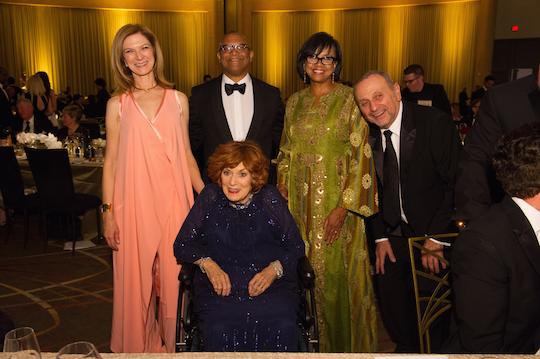
Here I am flanked by AMPAS CEO Dawn Hudson and President Cheryl Boone Isaacs (with her husband Stanley), with honoree Maureen O’Hara (seated).
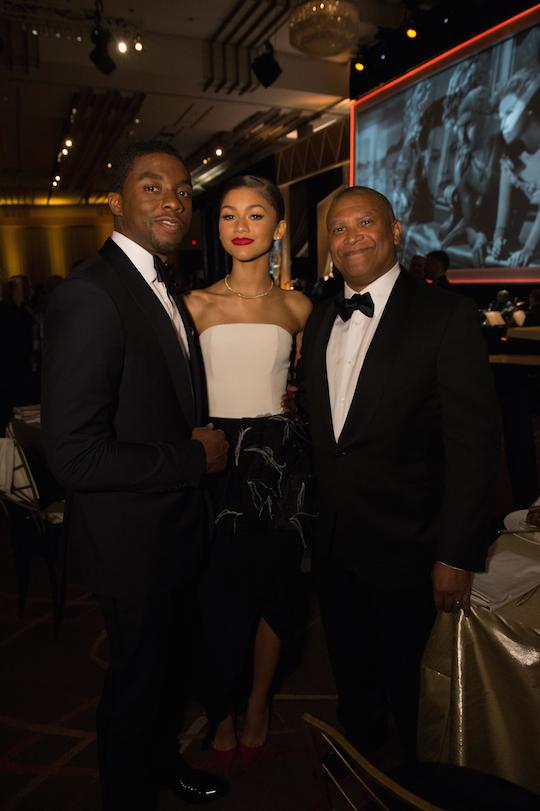
Star of the upcoming BLACK PANTHER movie Chadwick Boseman, singer and actress Zendaya and I talked a lot that night.
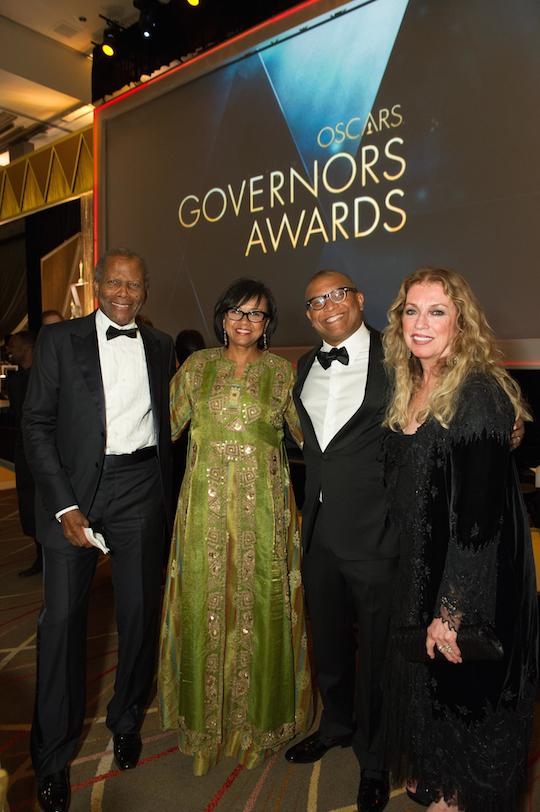
Sidney Poiter, Academy President Cheryl Boone Isaacs, me and Mrs. Poiter.
Governors Awards: Top Contenders Celebrate Legends at Dress Rehearsal for Oscars
by Scott Feinberg
As always, the Academy’s second biggest night was beautifully orchestrated, emotionally moving and attracted dozens of current Oscar hopefuls
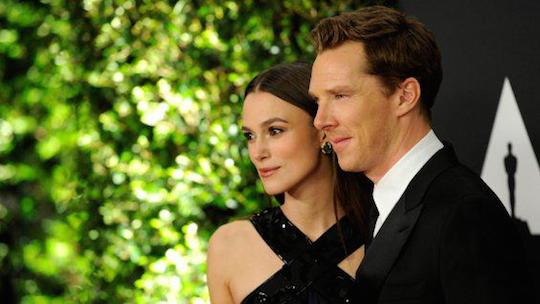
Photo by Chris Pizzello/Invision/AP
Keira Knightley and Benedict Cumberbatch at the Governors Awards
The Academy’s sixth annual Governors Awards was, like the five before it, as special a night as any on the Hollywood awards season calendar.
I refer to it as "special" because it was a beautifully orchestrated and moving ceremony (hat-tip to the evening’s producer, Reginald Hudlin, and Academy president Cheryl Boone Isaacs) celebrating four remarkable people: Golden Age actress Maureen O’Hara, prolific writer Jean-Claude Carriere and animation master Hayao Miyazaki received honorary Oscars, and 87-year-old actor-activist Harry Belafonte became the 37th recipient of the Jean Hersholt Humanitarian Award.
Liam Neeson salutes Maureen O’Hara!
Clint Eastwood talks about working with Maureen O’Hara.
I refer to it as part of the "awards season calendar" because it decidedly is. Each year, more and more tables are bought by studios and filled with Oscar-contending talent. They gamely show up, knowing that attendance guarantees them not only a chance to witness history, but also the opportunity to casually (or not so casually) rub shoulders with more Oscar voters and tastemakers than they will encounter in just about any other room prior to voting. Only 600 people are seated in the room, but almost everybody is somebody.
This all provides a close observer with the opportunity to witness some pretty cool things.
Before dinner, Jessica Chastain, a star of Interstellar (as well as A Most Violent Year, The Disappearance of Eleanor Rigby and Miss Julie) and perhaps the most beautiful and talented redheaded actress in the movies today, nervously approached O’Hara, perhaps the most beautiful and revered redheaded actress of Hollywood’s Golden Age. O’Hara happily agreed to pose with her for a photograph, in which Chastain grinned with delight.
Selma’s writer-director Ava DuVernay introduced me to the gorgeous young actress Tessa Thompson, who stars in Justin Simien‘s Dear White People and DuVernay’s forthcoming film. We all had a chuckle upon realizing that both of Thompson’s directors were film publicists until getting behind a camera quite recently. Now DuVernay is the director of one of the most anticipated films of the year.
Jack O’Connell, the star of the forthcoming Unbroken, did a classy thing and snuck away from the event for a few minutes to go downstairs to the Dolby Theatre and surprise an audience attending an AFI Fest screening of another of his films, 71, which will be out next year and could be an awards player.
I was able to introduce Laura Poitras, the director of the acclaimed Edward Snowden documentary Citizenfour — who is back from four days of much needed R&R in Berlin — to one of her heroes, the great Sidney Poitier, who was delighted to meet her. I snapped a picture of the two of them together and offered to email it to Poitras, who gave me an address that, she joked, will guarantee that the NSA gets a look at it, too.
Elsewhere around the room, Boyhood‘s young actress Lorelei Linklater and IFC’s chief Jonathan Sehring sat across from each other, surveying the scene. Birdman‘s Michael Keaton squeezed Wild‘s Reese Witherspoon in a big hug as the two Fox Searchlight contenders posed for a pic, with Birdman‘s Edward Norton looking on. And the date of The Gambler star Mark Wahlberg, his young daughter, just wanted to meet The Fault in Our Stars‘ Shailene Woodley — who, as fate would have it, was among the few 2014 Oscar contenders not present.
Once the show got underway, several others showed up onstage as presenters. American Sniper director Clint Eastwood was part of the O’Hara presentation, and John Lasseter, whose Disney-Pixar is distributing Big Hero 6, was at the center of the Miyazaki segment. Out in the audience, one could hear a pin drop as Harry Belafonte delivered his jaw-droppingly eloquent and moving speech — that is, until it ended, at which point whistles of approval from David Oyelowo, who plays Belafonte’s late friend Martin Luther King Jr. in Selma, pierced through the applause.
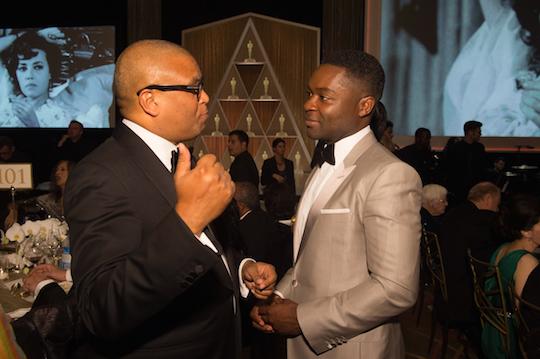
Me talking with SELMA star David Oyelowo.
Once the ceremony concluded, I boarded an elevator full of stars — among them The Judge‘s Robert Downey Jr. and Wild‘s Laura Dern — and headed down to the valet area, where the wait for cars to come around enabled many other contenders to congregate with one another. Dern and Jake Gyllenhaal, who have known each other since costarring in October Sky 15 years ago, chatted. Get On Up‘s Chadwick Boseman was introduced to Mr. Turner‘s Timothy Spall. And Rob Marshall, the director of the forthcoming Into the Woods, bowed before the great director Norman Jewison.
Among those waiting for their cars was The Imitation Game‘s director Morten Tyldum and star Benedict Cumberbatch, who were running late for a nearby post-screening Q&A, so when their film’s distributor Harvey Weinstein got his car, he offered them a lift, remarking of the moving evening, "This is what it’s all about."
Other contenders who were present included The Imitation Game actor Keira Knightley and composer Alexandre Desplat; The Judge actor Robert Duvall; Fury actor Logan Lerman; Fort Bliss actor Michelle Monaghan; Belle actor Gugu Mbatha-Raw; Dawn of the Planet of the Apes and The Hobbit: The Battle of Five Armies actor Andy Serkis; The Theory of Everything actors Eddie Redmayne and Felicity Jones; Into the Woods actors Emily Blunt and James Corden; Whiplash writer-director Damien Chazelle and actor J.K. Simmons; A Most Violent Year writer-director J.C. Chandor and actor Oscar Isaac; Obvious Child actress Jenny Slate; Snowpiercer actress Tilda Swinton; Cake actor Jennifer Aniston; Boyhood writer-director Richard Linklater and actors Ellar Coltrane, Ethan Hawke and Patricia Arquette; Two Days, One Night directors Jean-Pierre Dardenne and Luc Dardenne and actress Marion Cotillard; Foxcatcher director Bennett Miller and actors Steve Carell, Channing Tatum and Mark Ruffalo; Black and White writer-director Mike Binder and actors Kevin Costner and Octavia Spencer; The Homesman actress Hilary Swank and composer Marco Beltrami; Big Eyes actor Christoph Waltz; Wild director Jean-Marc Vallee; Get On Up director Tate Taylor; How to Train Your Dragon 2 director Dean DeBlois; American Sniper screenwriter Jason Hall; The Lego Movie writer-directors Phil Lord and Christopher Miller; Inherent Vice actor Katherine Waterston; Gone Girl composer Atticus Ross; and The Human Capital director Paolo Virzi.
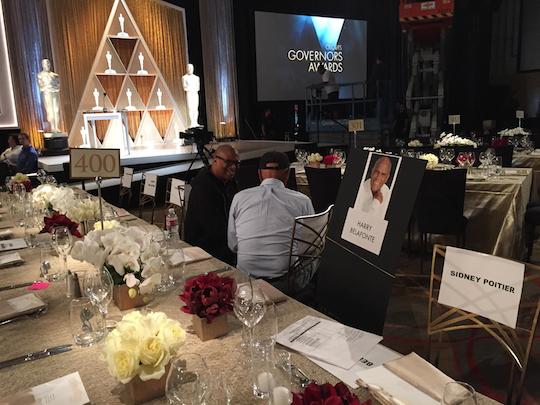
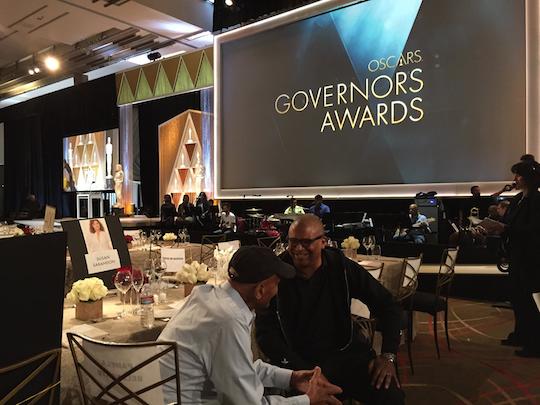
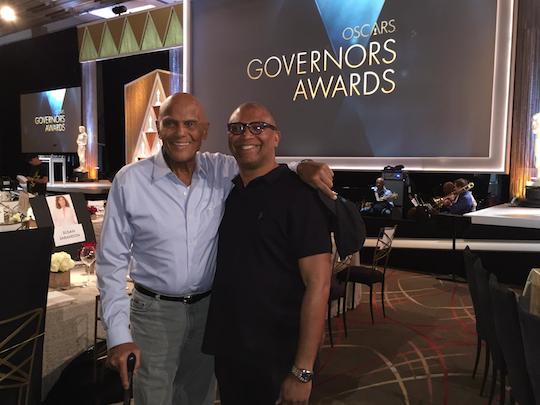
A memorable conversation with Mr. Belafonte during rehearsal the day before the show. Thank you to his wife Pamela Belafonte for the photos!
Chris Rock celebrates Harry Belafonte as only he can.
Susan Sarandon introduced Harry Belafonte.
The speech of the night….of the season!
Belafonte Electrifies Governors Awards, Issues Challenge to Hollywood
Tim Gray, Awards Editor, @timgray_variety
Harry Belafonte gave one of the all-time great acceptance speeches at Saturday night’s Governors Awards, citing Hollywood’s often-shameful power to influence attitudes, and challenging the heavy-hitters in the room to instead create works that allow global audiences “to see the better side of who we are as a species.”
The performer, receiving the Jean Hersholt Humanitarian Award, pulled no punches, and his words were all the more effective because of the soft, even tone in his voice and the cautious optimism that concluded his speech.
The occasion was the sixth annual Governors Awards, at the Ray Dolby Ballroom at Hollywood & Highland, an annual gathering that always mixes a celebration of Hollywood’s past, some words of encouragement to the room’s artists, and a heavy dose of awards-schmoozing.
The three recipients of Honorary Oscars — Maureen O’Hara, Hayao Miyazaki and Jean-Claude Carriere — all provided moments that were touching and charming. But, concluding the evening with a long and electric speech, Belafonte took things to a whole other level.
He reminded the crowd about “Birth of a Nation,” the early “Tarzan” films (depicting “inept, ignorant Africans”) and “i,” as well as the industry’s cowardice during the McCarthy hearings. He also referred to the industry’s decades-long treatment of Native Americans in films, “and at the moment, Arabs aren’t looking so good.” The industry doesn’t like trouble-makers and “on occasion, I have been one of its targets.”
But he said that “today’s harvest of films yields sweeter fruit,” citing “Schindler’s List,” “Brokeback Mountain” and “12 Years a Slave” as examples. He also thanked such inspirations as Langston Hughes, James Baldwin, Eleanor Roosevelt and Paul Robeson, quoting the latter’s statement that “Artists are the gatekeepers of truth” as well as the radical voice of civilization.
He then called Sidney Poitier to the stage, recognizing the actor’s role in changing public attitudes toward blacks. And he added that he hopes things will improve this century: “Maybe it could be a civilization game-changer.”
The first recipient of the evening was Maureen O’Hara, now 94, who came onstage in a wheelchair and charmed everyone by singing a few lines of “Danny Boy.” She read her thanks and when her escort asked her to stand and take a bow, she said “Oh, no!” saying she intended to stay another 10 minutes onstage and tell her life story. She got partway through it, talking about growing up in the FitzSimons family in Ireland, but eventually her mike was removed and she exited the stage in a bittersweet moment.
Hayao Miyazaki, speaking with a translator, said he feels “lucky to be part of the last era when we can make films with paper, pencils and film.” Introducing him, John Lasseter hailed the Japanese filmmaker as one of animation’s greats, along with Walt Disney, and said Miyazaki has directed 11 animated features, more than anyone else in history.
Jean-Claude Carriere, who boasts 139 credits, said he was particularly pleased that an award was given to a scripter. “Very often screenwriters are like shadows passing through the history of cinema,” he said, accepting the award on behalf of all his fellow scribes throughout the world.
Clips of all the speeches are at the Academy of Motion Picture Arts & Sciences website, oscars.org.
Academy president Cheryl Boone Isaacs opened the evening by saluting the four honorees, who represent “the amazing global diversity of our industry.” (Later, Chris Rock got off the evening’s best one-liner by congratulating Boone Isaacs on her work: “It’s nice to see a black president that America still likes.”)
Among those in attendance were Academy CEO Dawn Hudson, the board of governors, Oscar show producers Craig Zadan and Neil Meron, studio honchos and a heavy dose of industry creatives. Megan Colligan, Paramount’s president of worldwide distribution and marketing, summed up the mood by saying “There’s always a real sense of community.”
That’s true even among the many awards hopefuls that were working the room. The event has become a key campaign stop for contenders, a chance to rub elbows with Academy voters and journalists.
There was a lot of cheery schmoozing. Producers Nora Grossman and Ido Ostrovsky (“The Imitation Game”) chatted with Bruna Papandrea (“Wild”), while animation directors Dean DeBlois (“How to Train Your Dragon 2″) palled around with Chris Williams (“Big Hero Six”).
Among attendees were directors Clint Eastwood, Richard Linklater, Rob Marshall, Bennett Miller, Morten Tyldum and Jean-Marc Vallée; and writers Dan Gilroy, Jason Dean Hall and Mike Binder.
There was an all-star lineup of actors, including Jennifer Aniston, Patricia Arquette, Steve Carell, Jessica Chastain, Kevin Costner, Benedict Cumberbatch, Laura Dern, Robert Downey Jr., Robert Duvall, Jake Gyllenhaal, Ethan Hawke, Felicity Jones, Michael Keaton, Keira Knightley, Logan Lerman, Edward Norton, David Oyelowo, Eddie Redmayne, Mark Ruffalo, J.K. Simmons, Timothy Spall, Octavia Spencer, Hilary Swank, Christoph Waltz and Reese Witherspoon. Composers included Alexandre Desplat, Atticus Ross and John Powell.
Producer of the event was Reginald Hudlin.
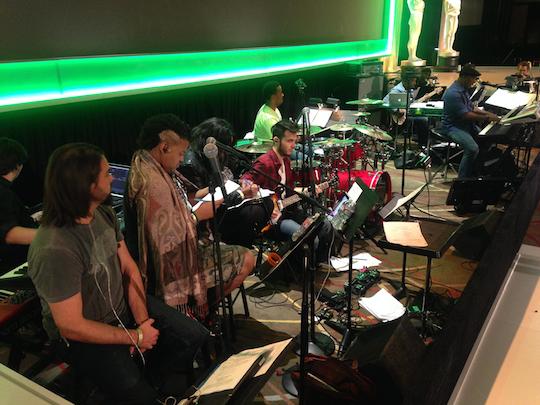
Ray Chew and his amazing band, which blew award the crowd with their renditions of Oscar songs, from Moon River to Live and Let Die to West Side Story to Shaft.
Talk about it on HEF – the Hudlin Entertainment Forum
11/29/14 by Reggie | Reginald Hudlin | Comments Off on Django/Zorro #1
It’s out! Available in stores, online and of course at Reggiesworld.com! Check out the first installment of DJANGO/ZORRO, the comic book sequel to DJANGO UNCHAINED.
I am executive editor of the book, and could not be more proud of the series. Here’s the opening pages with commentary from writer Matt Wagner:
Writer’s Commentary – Django / Zorro #1 By Matt Wagner
I first met Quentin Tarantino when we got together to discuss the possibility of co-writing the first official sequel to any of his films, a comic-book adventure that would match the title character of DJANGO UNCHAINED with a classic character that I had helped redefine in recent years—the original masked-and-caped crusader, ZORRO! Our connection was immediate and genuine and I knew that would translate into the adventures of our respective characters. Since the time frames of these two narratives were off by many years, I figured we’d need to invent a legacy version of Zorro—an all new character who takes up the masked identity for whatever reason in the years just preceding the American Civil War. But Quentin was adamant that we use the original Don Diego de la Vega in our tale. “No, no, no,” he insisted, “It’s gotta be the original Zorro! It’s gotta be your Zorro!” I immediately saw how well such a scenario could work; in the film, Django Freeman enjoys a close relationship with another older man who serves as something of a mentor during his budding days as a bounty hunter, Dr. King Schultz. This motif provided us with an easy basis for our heroes’ interaction and, just like that, our story was up and running!
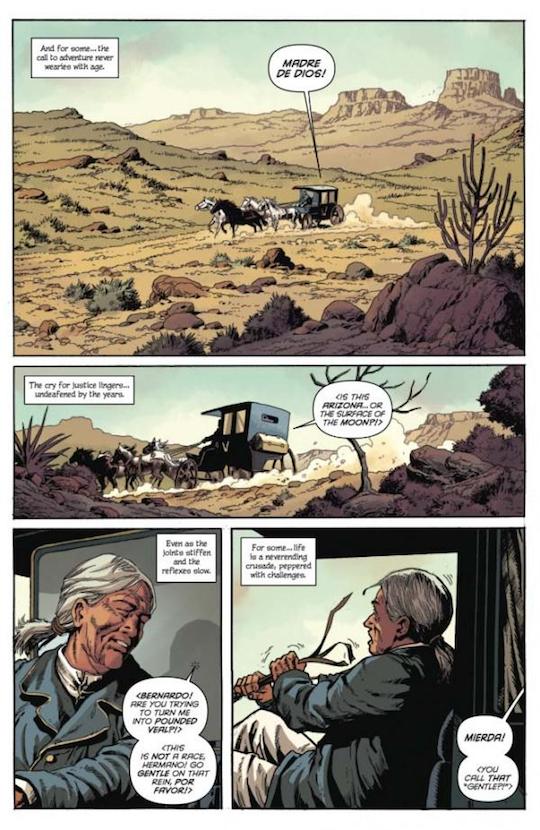
PG. 1—One of the things that intrigued us was the longterm effect of Diego’s masquerade on his personality. We immediately get from the narration that, despite his age, Diego has never really stopped his crusade as Zorro. To a great extent, Zorro is his truer persona—dashing, adventurous, always fighting for the cause of justice. But how would several decades of acting the part of the foppish aristocrat version of Don Diego affect him? To some degree…he must actually become that person as well. It’s an interesting concept…when does the man become the masquerade and the masquerade become the man? Thus, we hear Diego’s fussy and somewhat cantankerous commentary to his driver and milk-brother, Bernardo…who obviously enjoys pushing his friend’s buttons to some degree. Bernardo is also our initial narrator; as I had established in my first arc on writing Zorro, he has taken it upon to himself to act as chronicler for his hermano’s many astounding adventures.
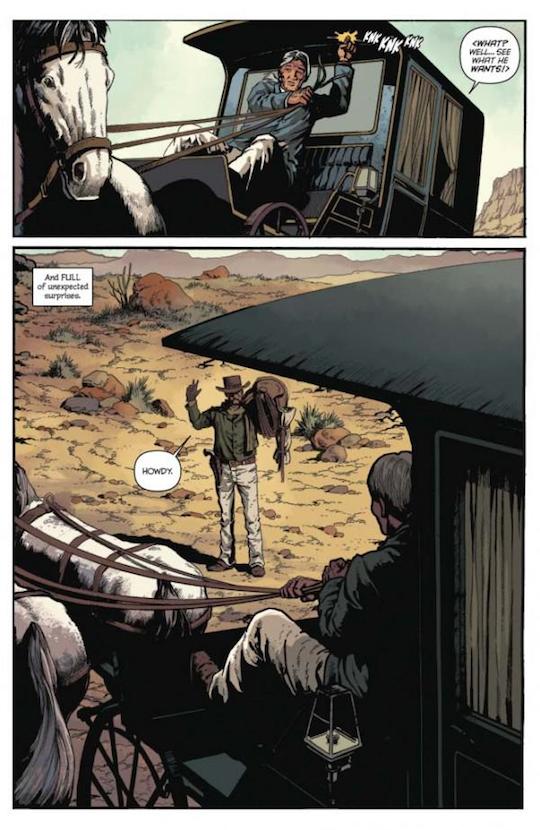
PG. 2—Here we see some of the secretive language that Diego and Bernardo (who is mute) have used since they were children. In this case, a coded knock that lets Diego know that they have encountered someone…unexpected. And, just like that, our two heroes’ paths converge.
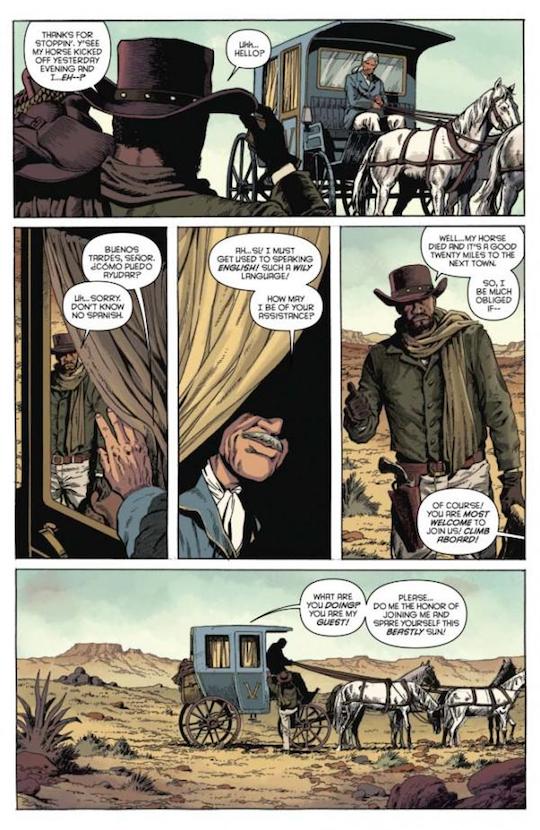
PG. 3—As he offers this dusty stranger a ride, the shadow from the carriage’s curtain mimics the shape of Zorro’s traditional mask on Diego’s face. Django, so used to racial segregation (at best) naturally assumes he’s supposed to ride up front with the driver.
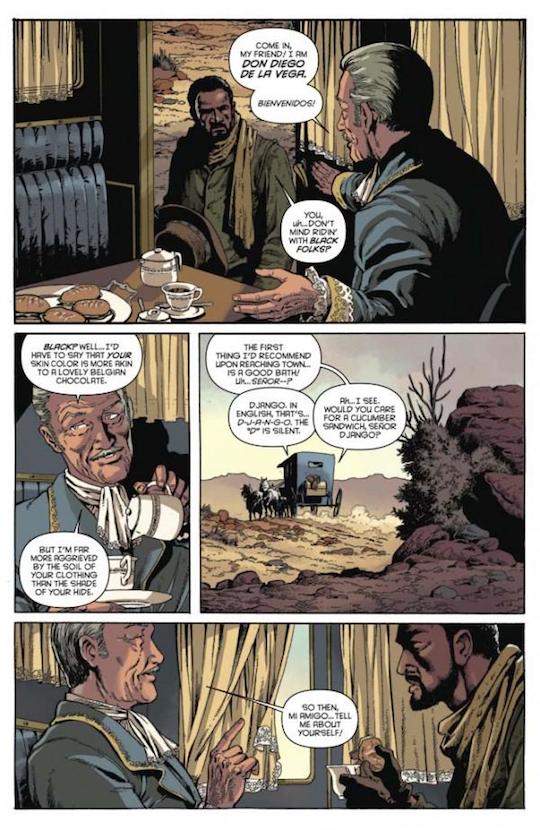
PG. 4—But, much to his surprise, this white man is seemingly devoid of racial prejudice and invites him to share his carriage compartment as an honored guest. I just love that final panel where we see the rough-and-tumble Django somewhat awkwardly holding a fine china tea-cup in one hand and a cucumber canapé in the other!
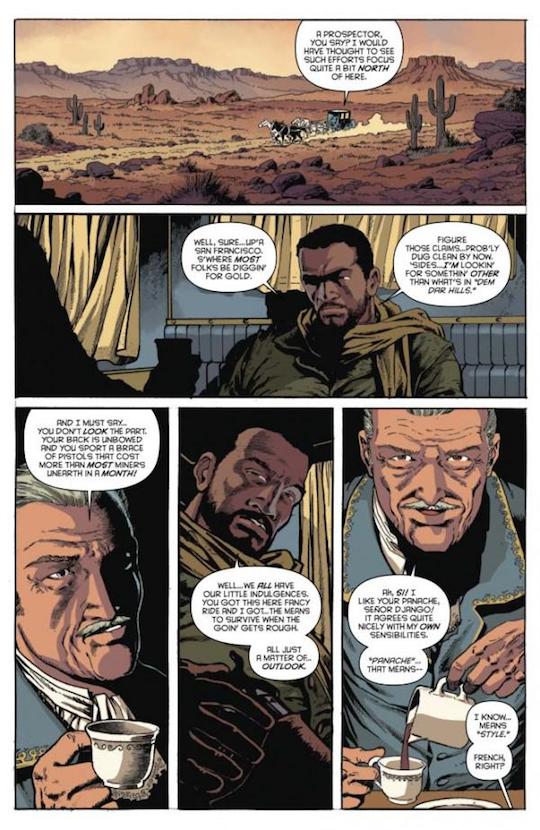
PG. 5—One of the things we decided early on was to not waste any time presenting these characters as if to new readers. If you’re buying and reading this comic at all, it’s a pretty safe bet that you’ve seen Django Unchained and, let’s face it, who doesn’t know who Zorro is? So…on this page we realize that Django isn’t being entirely upfront with his host by claiming to be a prospector. But Diego isn’t so easily fooled.
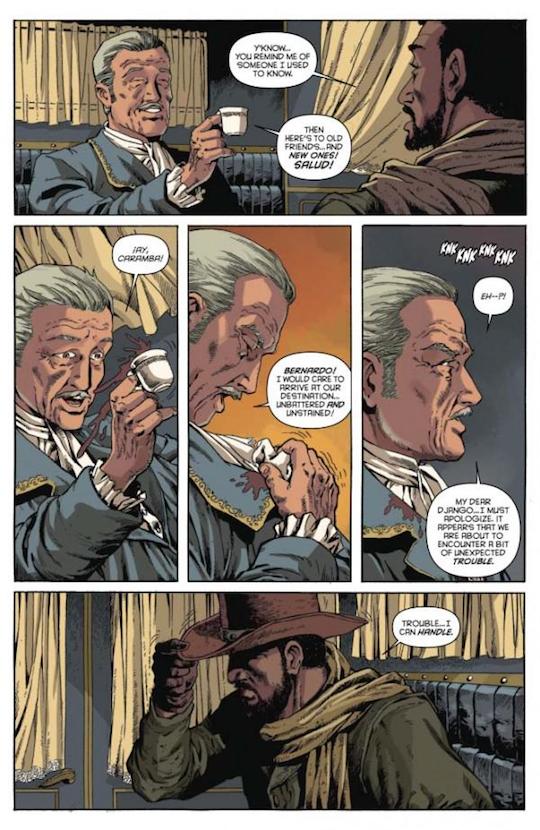
PG. 6—Django finds himself intrigued by this unassuming gentleman whom, he admits, reminds him of King. Then suddenly, this getting-to-know-you session is interrupted by another knock from Bernardo. But this is a different knock. A different code. Trouble brewing. And Django seems to have actually been ready and waiting for just such an intrusion.
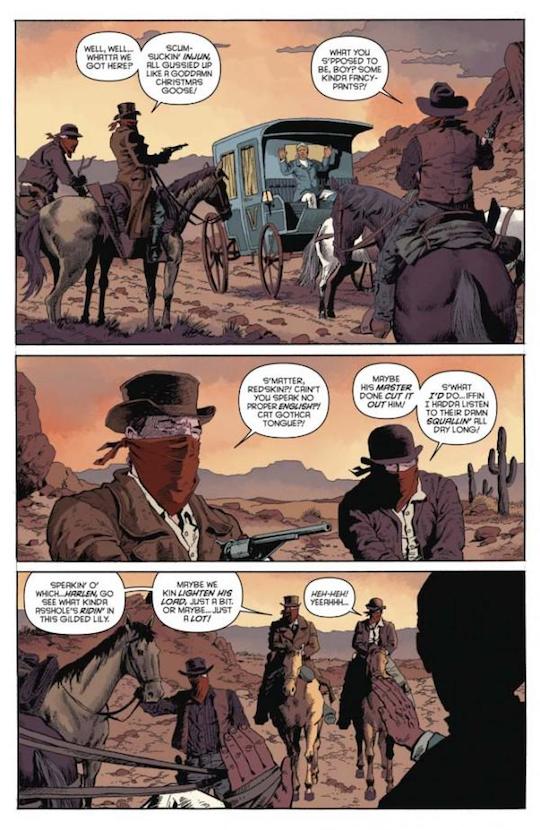
For more on Django / Zorro #1, click here.
Talk about it on HEF – the Hudlin Entertainment Forum
11/29/14 by Reggie | Interviews | Comments Off on Chris Rock References Reggie During Writer’s Roundtable
As the writer of TOP FIVE, the movie he just wrote, directed and starred in, Chris Rock was part of an hour long discussion among the top writers in the movie business.
What’s the best piece of advice someone has given you about filmmaking?
MOORE I had a moment, right before we shot our movie, I talked to my friend Fred who has made a bunch of movies. “As a writer on set, what’s my job?” And he was like, “Well, there’s one simple thing you have to remember: You’re the writer on set, shut the f— up!”
ROCK [Filmmaker] Reggie Hudlin said, “Eat with the crew.” Just eat with the crew. You’ll get more out of your crew if you just eat with your crew every day.
Talk about it on HEF – the Hudlin Entertainment Forum
11/29/14 by Reggie | I Love Your Smile | Comments Off on Governer's Awards Smiles
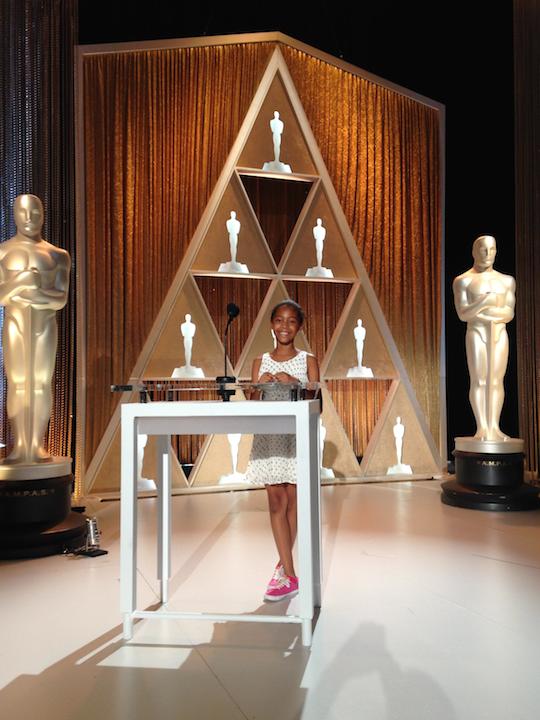
I’m big on the concept of Take Your Daughter To Work Days, so my daughter Helena attended the dress rehearsal for the Governor’s Awards.
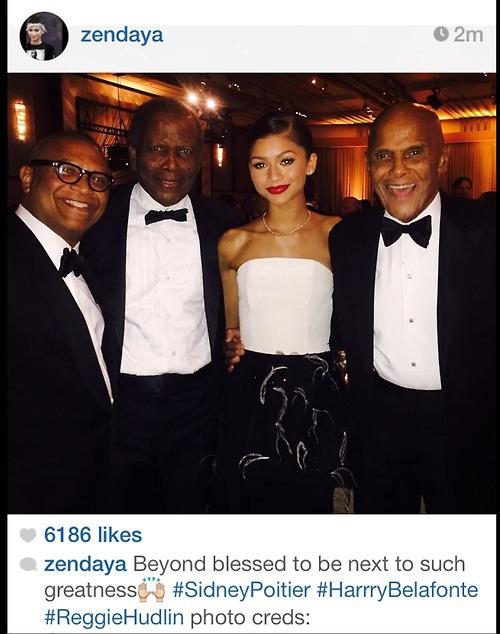
More beautiful smiles on HEF








 The characters have appeared sporadically since then — including “Static Shock” being incorporated into the DC Universe’s New 52 line in 2011 — and it looks like the new Milestone will continue this relationship with DC, while also expanding to other publishers.
The characters have appeared sporadically since then — including “Static Shock” being incorporated into the DC Universe’s New 52 line in 2011 — and it looks like the new Milestone will continue this relationship with DC, while also expanding to other publishers. “Golden Apple had ordered all these extra books for the event,” Hudlin continued. “By the end of the night, the stocks were bare. you could not find a copy of ‘Black Panther,’ or any Black character. The place was just stripped.”
“Golden Apple had ordered all these extra books for the event,” Hudlin continued. “By the end of the night, the stocks were bare. you could not find a copy of ‘Black Panther,’ or any Black character. The place was just stripped.”
 Cowan: Or you’re taking your life in your hands every time you go outside. There’s a lot of powerlessness that comes with that feeling.
Cowan: Or you’re taking your life in your hands every time you go outside. There’s a lot of powerlessness that comes with that feeling. There definitely seems to be increasing diversity in high-profile comic book-based adaptations — shows like “The Flash” and “Arrow” have major Black characters — but minorities haven’t been the lead character yet, as opposed to in this instance, and a few other upcoming projects. That seems like a huge part in the move forward.
There definitely seems to be increasing diversity in high-profile comic book-based adaptations — shows like “The Flash” and “Arrow” have major Black characters — but minorities haven’t been the lead character yet, as opposed to in this instance, and a few other upcoming projects. That seems like a huge part in the move forward.
 That’s right. Hudlin, Cowan and Dingle tell Comic Riffs that they are working together to revive the company that debuted more than 20 years ago before its demise in 1997 — a publisher that could boast of such heroes of color as Icon, Hardware and Static Shock. That means Milestone titles will soon return to comics shops physical and virtual.
That’s right. Hudlin, Cowan and Dingle tell Comic Riffs that they are working together to revive the company that debuted more than 20 years ago before its demise in 1997 — a publisher that could boast of such heroes of color as Icon, Hardware and Static Shock. That means Milestone titles will soon return to comics shops physical and virtual. “We’ve never just done black characters just to do black characters,” he continues. “It’s always come from a specific point of view, which is what made our books work. What we also didn’t do, which is the trend now, is [to] have characters that are, not blackface, but they’re the black versions of the already established white characters — as if it gives legitimacy to these black characters in some kind of way — [that] these characters are legitimate because now there’s a black Captain America.
“We’ve never just done black characters just to do black characters,” he continues. “It’s always come from a specific point of view, which is what made our books work. What we also didn’t do, which is the trend now, is [to] have characters that are, not blackface, but they’re the black versions of the already established white characters — as if it gives legitimacy to these black characters in some kind of way — [that] these characters are legitimate because now there’s a black Captain America.
















